
The Mamiya 645 series of cameras have been available since 1975 in a variety of models, culminating last summer with the Mamiya 645AFD III.Phase Onehad announced a "strategic alliance" with Mamiya some eighteen months before that, and when the 645AFD III was announced Phase One also announced that they were going to OEM the camera as the Phase One 645AF.
Then, earlier this year, both Mamiya and Phase One announced an updated camera which Phase One calls the 645DF, and it was also announced that Phase One had bought a controlling interest in Mamiya. In fact Phase One has now taken the lead in designing and developing new cameras and lenses which will be sold under both brand names.
And while we’re doing a history lesson, I should mention that Phase has also purchased medium format back maker Leaf, and has a new strategic relationship with Schneider-Kreuznach, one of the world’s venerable lens makers. Schneider is designing Phase One’s new line of leaf shutter lenses for the 645DF, and I am told future non-leaf shutter lenses as well. More on these shortly.
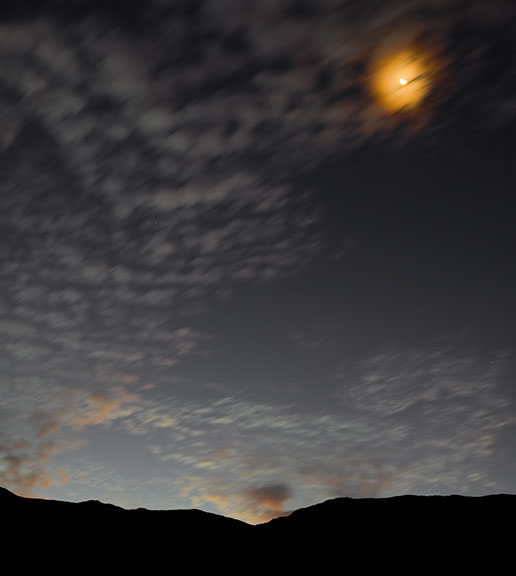
Badwater Moon. Death Valley, California. November, 2009
Phase One 645DF with 45mm lens. 10 sec @ f/8
P65+ back @ ISO 50
___________________________________________________________________________________
PODAS and Death Valley
In early November I was one of the guest instructors at aPhase One Digital Artist Seminar(PODAS) in Death Valley, California. All twenty five attendees were loaned a brand new 645DF camera and P65+ back for the week, along with a selection of Phase One / Mamiya lenses. These camera bodies were the first full production DF cameras off the assembly line.
Like the other independent instructors at this seminar; Bill Atkinson, Mark Dubovoy and Jeff Schewe, I am a Phase One camera and back owner. But I was also loaned a new 645DF camera by Phase for my use during the workshop, and for further testing and evaluation once I got home.
This report is based on my use of the 645DF in Death Valley, comments and feedback from the other thirty attendees and instructors, and my own continuing tests and shooting once I returned from our Death Valley shoot. And, to answer the inevitable question up front – yes – I have ordered a DF camera upgrade based on this experience.
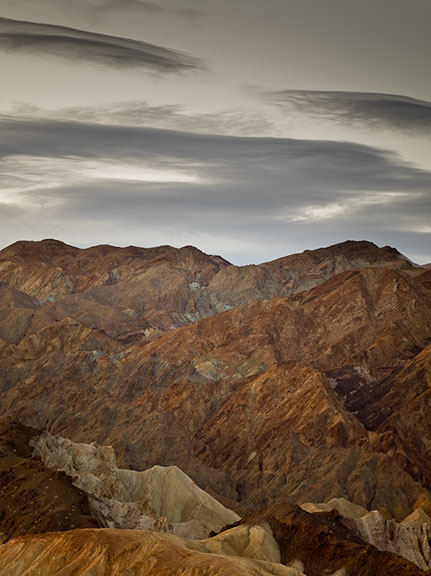
Artist’s Palette. Death Valley, California. November, 2009
Phase One 645DF with 210mm lens. 1/6 sec @ f/4
P65+ back @ ISO 50
___________________________________________________________________________________
The 645DF and its Competitors
Anyone new to medium format and Mamiya / Phase One cameras in particular, would do well to visit theWikipedia pagethat chronicles the almost 40 year history of the Mamiya 645 system, and also thePhase One web pagethat details the features of the new camera. Unlike traditional camera review sites I have no interest in detailing the same information here as one can find on the manufacturer’s web site or brochures.
I’ll also be focusing this report on the areas in which the Phase One 645DF (just called the 645DF from here-on) differs from its predecessor, the Mamiya AFDIII and Phase One 645AF.
At its heart it is a traditional medium format single lens reflex camera that can mount Phase One and Mamiya branded autofocus as well as manual focus lenses of just about any vintage. The camera also ships with a standard Hasselblad V series lens adaptor so that if you own legacy Hasselblad lenses, or enjoy searching eBay and camera shops for used bargains, these can be mounted as well (though of course without AF capability). A focus confirmation light is available though in the viewfinder.
You can mount just about any available brand of digital back on the camera, including those from Phase One, Mamiya, and Leaf. I conducted my tests with both my own P65+ back and a borrowed P40+ back. Note though that Mamiya film backs can not be used with the 645DF. Apparently the camera / back interface pins that used to drive the film advance mechanism are now used for a variety of integration functions, which precludes using film backs any longer. This is unfortunate for those of us that would like to use film as field backup and for very long exposures. The solution would appear to be an inexpensive used Mamiya camera for this purpose. And since any Phase back can work on any Phase / Mamiya camera model this provides another form of backup.
Not to put too fine a point on it, but this versatility makes the 645DF the most customizable medium format camera on the market. Its only real competitor, the Hasselblad H3DII and upcoming H4, can only take a Hasselblad brand back. Neither can a film back be mounted on the Hassy (as with the 645DF), but nor can even another Hasselblad back without the camera and back both being returned to the factory in Denmark for matching. This makes back rentals and field safety-backups problematic at best. A fully matched Hasselblad body and back becomes the only solution. Similarly with the upcoming Leica S2, which because it is an integrated camera requires a complete additional body as a backup solution.
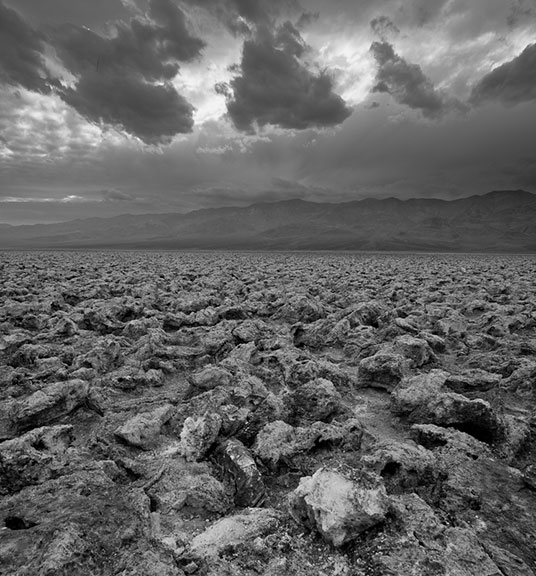
Devil’s Golf Course. Death Valley National Park, CA. November, 2009
Phase One 645DF with 210mm lens. 1/6 sec @ f/4
P65+ back @ ISO 50
___________________________________________________________________________________
What’s Changed?
Here in bullet point form are the main new features of the 645DF.
- Faster and more accurate autofocus
- Improved viewfinder
- Ability to accept Leaf Shutter as well as focal plane shutter lenses
- Auto selection of either leaf shutter or focal plane shutter
- 1/800 sec flash sync with LS lenses, (1/1,600 sec sync speed when used with a P40+ or P65+ back)
- Improved tactility on major controls
- Availability of AF activation on either front or rear control as well as shutter release
- Simplified Custom Function settings and enhanced LCD panel read-outs
- Faster shutter responsiveness
- More modular design (shutter assembly now dealer replaceable)
- Three new Custom Setting positions on the mode dial, each set-able with three different
custom function groups. - Ability to set and control all camera custom functions via the colour screen on P40+
and P65+ backs - Vertical grip coming Q1, 2010 which will offer the choice of 6 AA batteries or the use of
a second digital back battery. The grip will feature a USB port that will allow users to do
their own camera firmware upgrades
Please note that the leaf shutter lenses will also work on older firmware-updated 645AF and 645AFDIII models, but without the 1/1600 top sync speed.
The vertical grip can not be added to any previous model camera bodies, and control of the 645DF’s custom functions via the digital back’s screen is only possible with a P40+ or P65+ back, and one would presume future models as well.
Let’s look at these new features and fixes one at a time.
Autofocus
Let’s not beat around the bush. Mamiya / Phase One camera autofocus has until now been, shall we say, less than optimum. In other words, it mostly sucked. With the 645DF autofocus is now in the same league as other medium format cameras. Not better than, but as good – which is to say, not anywhere near as fast and full of tricks as even a mid-range DSLR. But it’s finally reliable, and doesn’t hunt the way it did on previous models.
As this is being completed for publication I am in the midst of testing a production Leica S2. My initial impression is that the S2 and the Phase One 645DF are evenly matched in autofocus performance.
Having said that, for those used to the previous generation Mamiya or Phase 645 camera the AF on the 645DF is streets ahead of anything we’ve had before.
There are two modes –FastandNormal. In Fast mode the camera hits the focus point and then stops. In Normal mode it continues past it, confirms that it is beyond and then returns, providing possibly greater accuracy. This is also pretty quick, but for a fashion shooter, for example, Fast will be the preferred mode.
On previous cameras we have not had the ability to do one-button autofocus. One had to focus by half pressing the shutter release and then activate the front AF lock button. Or, one can move the lens off of AF mode. None of these was really ideal.
Now with the 645DF the user can uncouple autofocus from the shutter button and place it on either a button on the front of the body or the rear of the grip under ones thumb. The other button then optionally becomes AE lock. Manual focus with the lens ring using the ground glass along with a focus confirmation light is also available, as are single and continuous AF modes.
Much faster and more positive autofocus, combined with claimed faster shutter actuation now makes the 645DF a much more responsive camera to shoot with, both in the field and in the studio.
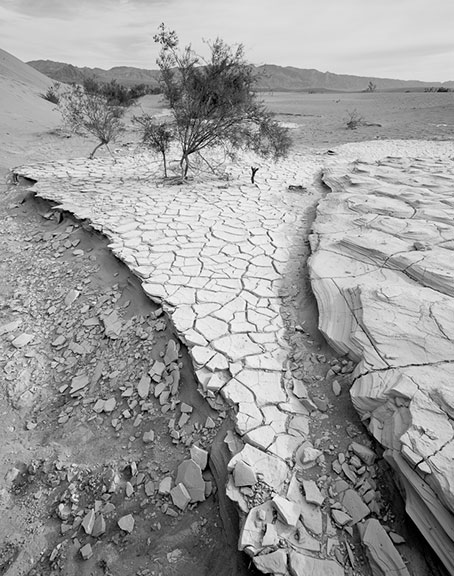
Baked. Death Valley National Park, CA. November, 2009
Phase One 645DF with 28mm lens. 1/30 sec @ f/16
P65+ back @ ISO 50
Button Tactility
The camera’s buttons now have a click membrane beneath them providing a much better level of tactility than before. This is all to the good, but I was not at all happy with the rear button when used for autofocus activation or lock. It is too small and deeply recessed for a button that is going to see a lot of use. As an occasional setting button the design is fine, and its design is intended to avoid accidental activation. But I think that it could have been better designed to simultaneously accomplish both goals. As a consequence I have programmed the front button to be AF actuation and the rear one AE lock, which I rarely use.
The Mode dial has also been changed. It now has three additional positions for custom function memory settings C1, C2 and C3, but it also no longer has a center button lock, something that I always appreciated because I really dislike cameras which can be inadvertently mis-set when handling.
I have to say that In my time using and testing the camera in the field and in the studio this never happened to me, but I was not alone among previous Phase and Mamiya owners at the PODAS workshop in bemoaning this change.
Viewfinder
Phase claims that the viewfinder has been improved, but I’m hard pressed to tell the difference. What has changed is the rubber eyecup which does a better job of light shielding, but which no longer properly accepts the 3X eyepiece magnifier.
Leaf Shutter Lenses
Phase One is introducing a brand new line of leaf shutter lenses, designed in cooperation with Schneider. In fact the lenses will be labeled as Schneider lenses. There will be an 55mm, a 80mm and 110mm f/2.8 leaf shutter lenses. I was also told that additional Schneider lenses are to be forthcoming, including ones for use with the camera’s focal plane shutter. Though Mamiya lenses have always been well regarded, and the new D series lenses designed by Phase One especially so, having a second line of lenses from one of the world’s greatest lens makers will be a real bonus for Phase One owners.
When an LS lens is attached one can choose via the camera’s custom function menu to have the camera automatically select whether to use the leaf shutter, use the camera’s focal plane shutter, or allow the camera to automatically select which is most appropriate. In the latter mode there is no need to set any switches when swapping between different types of lenses. This is a great design.
Focal plane X sync is 1/125 sec, while flash sync speed is normally up to 1/800 second with an LS lens. But, if you have a P40+ or P65+ back you can actually sync up to 1/1,600 second for complete versatility when doing daylight fill flash.
On one of the days at the Death Valley PODAS we did a late afternoon / sunset model shoot and I shot part of it with the 80mm f/2.8 Schneider LS lens. I was using a Metz 54 flash and had no trouble with balanced fill flash at up to 1/1,600 second with a P65+. I particularly liked the fact that switching back and forth between regular lenses and LS lenses is completely transparent, with no switches or other settings required.
Custom Function Settings Via The Digital Back
When I was given my sample 645DF and also a P65+ with updated firmware I was knocked out by a new and as yet previously unannounced capability, and that’s being able to set all of the camera’s custom functions via the back’s screen and buttons. Rather than doing so on the camera’s top LCD panel, with its small and somewhat cryptic legends, if using a P40+ or P65+ with updated firmware one now has the ability to do so with clear simple menus, similar to those of the back itself. What a pleasure!
This is particularly worthwhile when setting up the camera’s custom functions and modes, which I’ll now try and explain, because frankly they can be somewhat overwhelming in their variety.
As with the previous 645 AF camera there are three sets of custom settings, labeled A, B and C. Each can be programmed to include almost every camera setting that isn’t strictly mechanical. These include Single or Continuous shooting, Single or Continuous autofocus, and Mirror Lock Up mode.
Now, with the 645DF and its three new positions on the Mode dial (C1, C2, and C3), you can associate any of the three custom setting modes (A,B, or C) with any of C1, C2, or C3 Mode dial positions. Most importantly, even though these three settable positions share the dial with the usual A, P and S modes, you can combine one of these modes with the Custom position. Clear?
Here’s an example. You set custom setting A, for example, for landscape shooting, with 3 second self timer, Manual exposure, center point AF activated by the rear thumb button, and center point metering. You can now assign this combination of settings to mode dial position C1.
Similarly you can set an action shooting mode where the camera is in Program mode, with three point AF, matrix metering and continuous AF. You program these into Setting B and then assign this to mode dial C2.
Now, you can be doing a slow contemplative landscape shot with everything in manual mode, and when a bear comes rushing at you out of the woods you can instantly switch to an action shooting mode with the simple twist of a dial position. I wish that mirror lock up was a programmable position rather than on the shutter dial though. My recommendation to Phase One is that on next generation cameras it be placed as an optional function of the self-timer.
This all sounds a bit more complicated than it really is, though if you’re doing it from the camera’s top panel it is more obscure than one might want it to be. But with a P40+ or P65+ and the ability to make all settings via the back’s colour LCD, it’s a piece of cake.
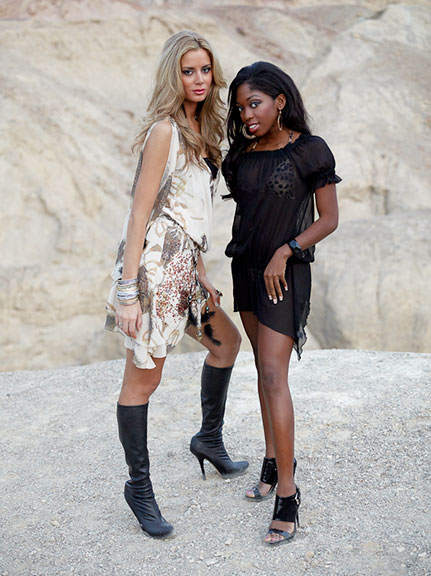
Models at Artist’s Palette. Death Valley National Park. November, 2009
Phase One 645DF with 75-150mm. 1/60 sec @ f/5
P65+ back at ISO 1,600 in Sensor+ Mode
___________________________________________________________________________________
Price
Phase One cameras and digital backs are sold world-wide through specialty pro-dealers and VARs. The 645DF together with a Schneider 80mm f/2.8 LS lens has a suggested list price of $5,990. But, since many people buy the camera with a digital back and possibly some additional lenses, there is scope for discounting, and so if you’re interested in purchasing one I suggest that you contact a local dealer in your area for a test drive and a quote.
___________________________________________________________________________________
The Bottom Line
There are really two questions one needs to ask oneself about the 645DF if a purchase is contemplated. If you’re already a Mamiya / Phase One camera owner the question is – should I upgrade to the 645DF? If you don’t currently own a medium format digital system, the question is of course a more complicated one.
First question. The improvements to the 645DF are for the most part incremental and not earth shaking. The autofocus improvement is considerable though, and if fast and accurate AF is what you’ve been missing then an upgrade will likely be worthwhile, as is the AF activation on a user set-able button, either front or rear.
If you currently have a P40+ or a P65+, or are contemplating the purchase of one of these or a future generation Phase back, then again I would recommend the upgrade. The new higher level of integration between the body and the backs is more than welcome. I’ve ordered mine.
If you are considering getting into medium format and a Phase One system is on your short list then there’s little question in my mind that the 645DF is a significant improvement on the 645AF, and worth the extra money. There are other systems to consider, including those from Hasselblad and Leica. As this is being written in mid-November I have only just started testing the Leica S2, so I’m not in a position to recommend one over the other. As for Hasselblad, I used to be a mostly satisfied long time H1 and H2 user, and if they hadn’t closed out third party backs I might still be using mine. The Contax 645 was a fantastic system, but alas is no more, and the Hy6 held great promise, but it too has gone to that great camera graveyard in the sky.
If you go the Hasselblad route you can choose from a range of their backs at different resolution and price levels, but that’s the limit of your choices. If you go with a Phase One camera you can use any one of a range of Phase One backs, as well as Leaf backs and models from Mamiya.
My recommendation is to find one or more local pro dealers or VARs that sell the equipment that you’re interested in and ask for an opportunity to test a system doing the kind of work that is your regular fare. This is the only way to really take the measure of an expensive medium format camera system. Reading online reviews such as this are one step in the decision making process, but by no means the most important. It’s how it feels inyourhands and how the images look toyoureyes and foryourneeds that are the most important criteria.
November, 2009
You May Also Enjoy...
Kiboko from Gura Gear
Most photographers I know have many different bags. However, choosing which to use, depending on the type of travel or shoot planned, can be a
The Synthesis of Chinese Landscape Painting and Photography
Huangshan, China, 2012 By George DeWolfe and Lydia Goetze Traditional Chinese Landscape Painting has endured for almost 1500 years, longer than any genre in Western culture.
